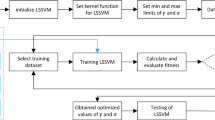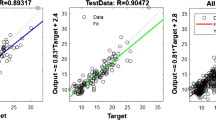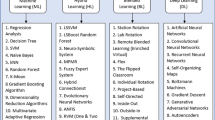Abstract
The compaction parameters are the most important parameters for any civil engineering project. In this work, the sand content, fine content, liquid limit, plastic limit, and plasticity index were used as input parameters by the soft computing models to predict the compaction parameters of soil. These soft computing models are gene expression programming (GEP), least square support vector machine (LSSVM), long short-term memory (LSTM), and artificial neural network (ANNs). For this purpose, three databases, i.e., training, testing, and validation, are prepared from the database available in the literature. Also, twelve soil samples are collected from and around Kota, Rajasthan, and tested in a laboratory for cross-validation of the best architecture models. The performance of models is measured by thirteen performance indicators, including three new indicators, i.e., a20-index, index of agreement (IOA), and index of scattering (IOS). The test performance comparison reveals that the polynomial LSSVM model MD15 (a20-index = 100.00%, IOA = 0.9371, IOS = 0.0519) and linear LSSVM model MD110 (a20-index = 100.00%, IOA = 0.9179, IOS = 0.0122) have the highest performance in predicting optimum moisture content (OMC) and maximum dry density (MDD), respectively. Also, models MD15 and MD110 have higher performance in the validation phase. Models MD15 and MD110 have predicted OMC and MDD of twelve soil samples with residuals of ± 1.776% and ± 0.044 g/cc, respectively. This study demonstrates ANN achieves high overfitting than the LSTM model in predicting the compaction parameters of soil. The LSSVM model represents overfitting in predicting OMC and underfitting in predicting MDD of soil. Finally, the present research introduces high-performance soft computing models for predicting the compaction parameters of fine-grained soil.









Similar content being viewed by others
Data availability
All data, models, and code generated or used during the study appear in the submitted article. The database may be provided on request.
Abbreviations
- AI:
-
Artificial intelligence
- ANN:
-
Artificial neural networks
- ASTM:
-
American Society for Testing and Materials
- C.L.:
-
Confidence level
- CC/ R:
-
Correlation coefficient
- CH:
-
Inorganic clays of high plasticity
- CI:
-
Inorganic clays of medium plasticity
- CL:
-
Inorganic clays of low plasticity
- D30 :
-
particle size at 30% finer
- D50 :
-
particle size at 50% finer
- FC:
-
Fine content
- GEP:
-
Gene expression programming
- GMDH:
-
Group method of data handling
- IS:
-
Indian Standards
- LL:
-
Liquid limit
- LSSVM:
-
Least-squares support vector machine
- LSTM:
-
Long short-term memory
- MAE:
-
Mean absolute error
- MARS:
-
Multivariate adaptive regression splines
- MD:
-
Model
- MDD:
-
Maximum dry density
- MEP:
-
Multiple expression programming
- MH:
-
Inorganic silts of high compressibility
- MI:
-
Inorganic silts of medium plasticity
- ML:
-
Inorganic silts with none to low plasticity
- MLR:
-
Multi-linear regression
- MPT:
-
Modified proctor test
- OH:
-
Organic clays of medium to high plasticity
- OI:
-
Organic silts of medium plasticity
- OL:
-
Organic silts of low plasticity
- OMC:
-
Optimum moisture content
- PI:
-
Plasticity index
- PL:
-
Plastic limit
- RMSE:
-
Root mean square error
- S:
-
Sand content
- SM:
-
Supplementary materials
- SPT:
-
Standard proctor test
- St.Dev.:
-
Standard deviation
- SVM:
-
Support vector machine
References
Ajalloeian R, Mojtaba K (2015) Predicting maximum dry density, optimum moisture content and California bearing ratio (CBR) through soil index using ordinary least squares (OLS) and artificial neural networks (ANNS). Int J Innov Technol Explor Eng 3(3):1–5
Alim MA, Akhi AH, Alam MA, Roknuzzaman M (2021) Prediction of compaction characteristics of soil using plastic limit, Proceedings of International Conference on Planning, Architecture & Civil Engineering held at Rajshahi University of Engineering & Technology, Rajshahi, Bangladesh, 215–220
Al-Jabban W, Laue J, Knutsson S, Al-Ansari N (2019) Effect of disintegration times of the homogeneity of soil prior to treatment. Appl Sci 9(22):4791. https://doi.org/10.3390/app9224791
Al-Khafaji AN (1993) Estimation of soil compaction parameters by means of Atterberg limits. Q J Eng GeolHydrogeol 26:359–368. https://doi.org/10.1144/GSL.QJEGH.1993.026.004.10
Al-Saffar R, Khattab S (2013) Prediction of soil's compaction parameter using artificial neural network. Al-Rafidain Engineering Journal (AREJ) 21(3):15–27. https://doi.org/10.33899/rengj.2013.75444
Al-Soudany K (2018) Remediation of clayey soil using silica fume. In MATEC Web of Conferences 162:01017. https://doi.org/10.1051/matecconf/201816201017
AL-Soudany KY (2018) Improvement of expansive soil by using silica fume. Kufa J Eng 9(1):222–239
Ardakani A, Kordnaeij A (2019) Soil compaction parameters prediction using GMDH-type neural network and genetic algorithm. Eur J Environ Civ Eng 23(4):449–462. https://doi.org/10.1080/19648189.2017.1304269
Armaghani DJ, Mirzaei F, Shariati M, Trung NT, Shariati M, Trnavac D (2020a) Hybrid ANN-based techniques in predicting cohesion of sandy-soil combined with fiber. Geomechanics and Engineering, 20(3), pp.191–205, https://doi.org/10.12989/gae.2020.20.3.191
Armaghani DJ, Mirzaei F, Toghroli A, Shariati A (2020b) Indirect measure of shear strength parameters of fiber-reinforced sandy soil using laboratory tests and intelligent systems. Geomech Eng, 22(5), pp.397–414, https://doi.org/10.12989/gae.2020.22.5.397
Asteris PG, Mamou A, Hajihassani M, Hasanipanah M, Koopialipoor M, Le TT, Kardani N, Armaghani DJ (2021) Soft computing based closed form equations correlating L and N-type Schmidt hammer rebound numbers of rocks. Transportation Geotechnics, 29, p.100588, https://doi.org/10.1016/j.trgeo.2021.100588
Benson CH, Trast JM (1995) Hydraulic conductivity of thirteen compacted clays. Clays Clay Miner 43(6):669–681. https://doi.org/10.1346/CCMN.1995.0430603
Benson CH, Zhai H, Wang X (1994) Estimating hydraulic conductivity of compacted clay liners. J Geotech Eng 120(2):366–387
Bunawan AR, Momeni E, Armaghani DJ, Rashid ASA (2018) Experimental and intelligent techniques to estimate bearing capacity of cohesive soft soils reinforced with soil-cement columns. Measurement 124:529–538. https://doi.org/10.1016/j.measurement.2018.04.057
Bunyamin SA, Ijimdiya TS, Eberemu AO, Osinubi KJ (2018) Artificial neural networks prediction of compaction characteristics of black cotton soil stabilized with cement kiln dust. J Soft Comput Civil Eng, 2(3), pp.50–71, https://doi.org/10.22115/SCCE.2018.128634.1059
Ceryan N, Samui P (2020) Application of soft computing methods in predicting uniaxial compressive strength of the volcanic rocks with different weathering degree. Arabian Journal of Geosciences, 13(7), pp.1–18., 288, https://doi.org/10.1007/s12517-020-5273-4
Di Matteo L, Bigotti F, Ricco R (2009) Best-fit models to estimate modified proctor properties of compacted soil. J Geotech Geoenviron Eng 135(7):992–996. https://doi.org/10.1061/(ASCE)GT.1943-5606.0000022
Ding W, Nguyen MD, Mohammed AS, Armaghani DJ, Hasanipanah M, Van Bui L, Pham BT (2021) A new development of ANFIS-Based Henry gas solubility optimization technique for prediction of soil shear strength. Transportation Geotechnics, 29, p.100579, https://doi.org/10.1016/j.trgeo.2021.100579
Edil TB, Acosta HA, Benson CH (2006) Stabilizing soft fine-grained soils with fly ash. J Mater Civ Eng 18(2):283–294. https://doi.org/10.1061/(ASCE)0899-1561(2006)18:2(283)
El-Hasan T, Mahasneh BZ, Hadi NA, Abdelhadi M (2014) High calcium ash incorporated into clay, sand and cement mortars used for encapsulating of heavy metals. Jordan J Earth Environ Sci 6:23–28
Farooq K, Khalid U, Mujtaba H (2016) Prediction of compaction characteristics of fine-grained soils using consistency limits. Arab J Sci Eng 41(4):1319–1328. https://doi.org/10.1007/s13369-015-1918-0
Farooq K, Rogers JD, Ahmed MF (2015) Effect of densification on the shear strength of landslide material: a case study from salt range Pakistan. Earth Sci Res 4(1):113
Gers FA, Schmidhuber J, Cummins F (2000) Learning to forget: continual prediction with LSTM. Neural Comput 12(10):2451–2471. https://doi.org/10.1162/089976600300015015
Ghorbani B, Arulrajah A, Narsilio G, Horpibulsuk S, Bo MW (2020) Development of genetic-based models for predicting the resilient modulus of cohesive pavement subgrade soils. Soils Found 60(2):398–412. https://doi.org/10.1016/j.sandf.2020.02.010
Günaydin O, Özbeyaz A, Söylemez M (2018) Regression analysis of soil compaction parameters using support vector method. Celal Bayar University Journal of Science, 14(4), pp.443–447, https://doi.org/10.18466/cbayarfbe.449644
Günaydın OJEG (2009) Estimation of soil compaction parameters by using statistical analyses and artificial neural networks. Environ Geol 57(1):203–215. https://doi.org/10.1007/s00254-008-1300-6
Gurtug Y, Sridharan A (2004) Compaction behaviour and prediction of its characteristics of fine grained soils with particular reference to compaction energy. Soils Found 44(5):27–36. https://doi.org/10.3208/sandf.44.5_27
Hair J Jr, Wolfnibarger MC, Ortinau DJ, Bush RP (2013) Essentials of marketing. Mc Graw Hill, New York
Hasanzadehshooiili H, Lakirouhani A, Medzvieckas J (2012) Superiority of artificial neural networks over statistical methods in prediction of the optimal length of rock bolts. J Civ Eng Manag 18(5):655–661. https://doi.org/10.3846/13923730.2012.724029
Hasnat A, Hasan MM, Islam MR, Alim MA (2019) Prediction of compaction parameters of soil using support vector regression. Curr Trends Civil Struct Eng 4(1):1–7. https://doi.org/10.33552/CTCSE.2019.04.000580
Hossein Alavi A, Hossein Gandomi A, Mollahassani A, Akbar Heshmati A, Rashed A (2010) Modeling of maximum dry density and optimum moisture content of stabilized soil using artificial neural networks. J Plant Nutr Soil Sci 173(3):368–379. https://doi.org/10.1002/jpln.200800233
Ibrahim KMHI (2015) Effect of percentage of low plastic fines on the unsaturated shear strength of compacted gravel soil. Ain Shams Eng J 6(2):413–419. https://doi.org/10.1016/j.asej.2014.10.012
IHRB Project TR-461, FHWA Project 4 (2005), Fly ash soil stabilization for non-uniform subgrade soils, Vol. I: Engineering Properties and Construction Guidelines”, Iowa State University, Project
Jayan J, Sankar N (2015) Prediction of compaction parameters of soils using artificial neural network. Asian J Eng Technol, 3(4). Retrieved from https://www.ajouronline.com/index.php/AJET/article/view/3049
Jalal FE, Xu Y, Iqbal M, Jamhiri B, Javed MF (2021) Predicting the compaction characteristics of expansive soils using two genetic programming-based algorithms. Transp Geotech 30:100608. https://doi.org/10.1016/j.trgeo.2021.100608
Khalid U (2018) Evaluation of compaction parameters of fine-grained soils using standard and modified efforts. Intl J Geo-Eng 9(1):1–17. https://doi.org/10.1186/s40703-018-0083-1
Khatti J, Grover KS (2023) Prediction of compaction parameters of compacted soil using LSSVM, LSTM, LSBoostRF, and ANN. Innov Infrastr Solut 8(2):76. https://doi.org/10.1007/s41062-023-01048-2
Khatti J, Grover KS (2022a) Determination of suitable hyperparameters of artificial neural network for the best prediction of geotechnical properties of soil, Intl J Res Appl Sci Eng Technol, 10(5), p.4934–4961, https://doi.org/10.22214/ijraset.2022.43662
Khatti J, Grover KS (2022b) Prediction of soaked CBR of fine-grained soils using soft computing techniques. Multiscale and Multidisciplinary Modeling, Experiments and Design, pp.1–25, https://doi.org/10.1007/s41939-022-00131-y
Khuntia S, Mujtaba H, Patra C, Farooq K, Sivakugan N, Das BM (2015) Prediction of compaction parameters of coarse grained soil using multivariate adaptive regression splines (MARS). Int J Geotech Eng 9(1):79–88. https://doi.org/10.1179/1939787914Y.0000000061
KS N, Chew YM, Osman MH, SK MG (2015) Estimating maximum dry density and optimum moisture content of compacted soils, Intl Conf Adv Civil Environ Eng 2015, 1-8
Kumar M, Kumar V, Biswas R, Samui P, Kaloop MR, Alzara M, Yosri AM (2022) Hybrid ELM and MARS-based prediction model for bearing capacity of shallow foundation. Processes 10(5):1013. https://doi.org/10.3390/pr10051013
Kurnaz TF, Kaya Y (2020) The performance comparison of the soft computing methods on the prediction of soil compaction parameters. Arab J Geosci 13(4):1–13. https://doi.org/10.1007/s12517-020-5171-9
Majidi A, Lashgaripour G, Shoaie Z, Nashlaji MN, Firouzei Y (2014) Estimating compaction parameters of marl soils using multi-layer perceptron neural networks. J Balkan Tribol Assoc 20(2):170–198
Manjunath KV, Kuma B, Kumar K, Imran M, Mahto NK (2012) June. Stabilization of red soil using ground granulated blast furnace slag. In Proceedings of International Conference on Advances in Architecture and Civil Engineering (AARCV 2012) (Vol. 21, p. 391)
Sinha SK, Wang MC (2008) Artificial neural network prediction models for soil compaction and permeability. Geotech Geol Eng 26(1):47–64. https://doi.org/10.1007/s10706-007-9146-3
Mawlood Y, Salih A, Hummadi R, Hasan A, Ibrahim H (2021) Comparison of artificial neural network (ANN) and linear regression modeling with residual errors to predict the unconfined compressive strength and compression index for Erbil City soils Kurdistan-Iraq. J Geosci 14(6):1–14. https://doi.org/10.1007/s12517-021-06712-4
Mentaschi L, Besio G, Cassola F, Mazzino A (2013) Problems in RMSE-based wave model validations. Ocean Model 72:53–58. https://doi.org/10.1016/j.ocemod.2013.08.003
Mujtaba H, Farooq K, Sivakugan N, Das BM (2013) Correlation between gradational parameters and compaction characteristics of sandy soils. Int J Geotech Eng 7(4):395–401. https://doi.org/10.1179/1938636213Z.00000000045
Nagaraj HB, Reesha B, Sravan MV, Suresh MR (2015) Correlation of compaction characteristics of natural soils with modified plastic limit. Transportation Geotechnics 2:65–77. https://doi.org/10.1016/j.trgeo.2014.09.002
Omar M, Shanableh A, Basma A, Barakat S (2003) Compaction characteristics of granular soils in United Arab Emirates. Geotech Geol Eng 21(3):283–295. https://doi.org/10.1023/A:1024927719730
Oyediran IA, Okosun J (2013) An attempt to improve geotechnical properties of some highway lateritic soils with lime. RMZ–M&G, 60, pp.287–296
Patra C, Sivakugan N, Das B, Rout S (2010) Correlations for relative density of clean sand with median grain size and compaction energy. Int J Geotech Eng 4(2):195–203. https://doi.org/10.3328/IJGE.2010.04.02.195-203
Pham BT, Nguyen MD, Nguyen-Thoi T, Ho LS, Koopialipoor M, Quoc NK, Armaghani DJ, Van Le H (2021) A novel approach for classification of soils based on laboratory tests using Adaboost, Tree and ANN modeling. Transportation Geotechnics, 27, p.100508, https://doi.org/10.1016/j.trgeo.2020.100508
Rahimi MR, Mohammadi SD, Heidari M, Jalali SH (2020) Evaluation of the needle penetration test to estimate the uniaxial compressive strength of gypsum rocks. Arab J Geosci 13(1):1–15. https://doi.org/10.1007/s12517-019-4989-5
Rehman AU, Farooq K, Mujtaba H (2017) Prediction of California bearing ratio (CBR) and compaction characteristics of granular soils. Acta Geotechnica Slovenica 14(1):63–72
Ris RC, Holthuijsen LH, Booij N (1999) A third-generation wave model for coastal regions: 2 Verification. J Geophys Res Oceans 104(C4):7667–7681. https://doi.org/10.1029/1998JC900123
Saikia A, Baruah D, Das K, Rabha HJ, Dutta A, Saharia A (2017) Predicting compaction characteristics of fine-grained soils in terms of Atterberg limits. Intl J Geosyn Ground Eng 3(2):1–9. https://doi.org/10.1007/s40891-017-0096-4
Salim N, Al-Soudany K, Jajjawi N (2018b) Geotechnical properties of reinforced clayey soil using nylons carry’s bags by products. In MATEC Web of Conferences (Vol. 162, p. 01020). EDP Sciences, 1–6, https://doi.org/10.1051/matecconf/201816201020
Salim NM, AL-Soudany KY, Ahmed AA (2018a) November. The impact of using recycled plastic fibres on the geotechnical properties of soft Iraqi soils. In IOP Conference Series: Materials Science and Engineering (Vol. 433, No. 1, p. 012017). IOP Publishing, https://doi.org/10.1088/1757-899X/433/1/012017
Sanuade OA, Adesina RB, Amosun JO, Fajana AO, Olaseeni OG (2017) Using artificial neural network to predict dry density of soil from thermal conductivity. RMZ–M&G, 64, pp.237–012, https://doi.org/10.1515/rmzmag-2017-0012
Senol A, Bin-Shafique MS, Edil TB, Benson CH (2002) September. Use of class C fly ash for stabilization of soft subgrade. In Fifth International Congress on Advances in Civil Engineering (pp. 25–27). Istanbul, Turkey: Istanbul Technical University
Hochreiter S, Schmidhuber J (1997) Long short-term memory. Neural Comput 9(8):1735–1780. https://doi.org/10.1162/neco.1997.9.8.1735.PMID9377276.S2CID1915014
Sepp Hochreiter, Schmidhuber Juergen (1996), LSTM can solve hard long time lag problems, Advances in Neural Information Processing Systems
Shrivastava K, Jain PK, Azad M (2016) Prediction of compaction parameters using regression and ANN tools. Intl J Sci Res Dev 3(11):2321–613
Sivrikaya O, Kayadelen C, Cecen E (2013) Prediction of the compaction parameters for coarse-grained soils with fines content by MLA and GEP. Acta Geotechnica Slovenica 10(2):29–41
Smith GN (1986) Probability and statistics in civil engineering – an introduction. Collins, London
Sridharan A, Nagaraj HB (2005) Plastic limit and compaction characteristics of finegrained soils. Proc Inst Civil Eng-Ground Improve 9(1):17–22. https://doi.org/10.1680/grim.2005.9.1.17
Suman S, Mahamaya M, Das SK (2016) Prediction of maximum dry density and unconfined compressive strength of cement stabilised soil using artificial intelligence techniques. Intl J Geosyn Ground Eng 2(2):1–11. https://doi.org/10.1007/s40891-016-0051-9
Taştan EO (2005) Stabilization of organic soils using fly ash (Doctoral dissertation, University of Wisconsin--Madison)
Tenpe AR, Patel A (2020) Utilization of support vector models and gene expression programming for soil strength modeling. Arab J Sci Eng 45(5):4301–4319. https://doi.org/10.1007/s13369-020-04441-6
Verma G, Kumar B (2020) Prediction of compaction parameters for fine-grained and coarse-grained soils: a review. Int J Geotech Eng 14(8):970–977. https://doi.org/10.1080/19386362.2019.1595301
Vukićević M, Maraš-Dragojević S, Jocković S, Marjanović M, Pujević V (2013) September. Research results of fine-grained soil stabilization using fly ash from Serbian electric power plants. In 18th International Conference on Soil Mechanics and Geotechnical Engineering (pp. 2–6)
Wang HL, Yin ZY (2020) High performance prediction of soil compaction parameters using multi expression programming. Engineering Geology, 276, p.105758, https://doi.org/10.1016/j.enggeo.2020.105758
Willmott CJ, Robeson SM, Matsuura K (2012) A refined index of model performance. Int J Climatol 32(13):2088–2094. https://doi.org/10.1002/joc.2419
Zhang W, Gu X, Tang L, Yin Y, Liu D, Zhang Y (2022) Application of machine learning, deep learning and optimization algorithms in geoengineering and geoscience: comprehensive review and future challenge. Gondwana Res. https://doi.org/10.1016/j.gr.2022.03.015
Zhang W, Li H, Li Y, Liu H, Chen Y, Ding X (2021a) Application of deep learning algorithms in geotechnical engineering: a short critical review. Artif Intell Rev 54(8):5633–5673. https://doi.org/10.1007/s10462-021-09967-1
Zhang W, Wu C, Zhong H, Li Y, Wang L (2021b) Prediction of undrained shear strength using extreme gradient boosting and random forest based on Bayesian optimization. Geosci Front 12(1):469–477. https://doi.org/10.1016/j.gsf.2020.03.007
Zhang X, Zhu Z (2020) Microscopic mechanism of cement improving the strength of lime-fly ash-stabilized yellow river alluvial silt. Adv Civil Eng 2020:1–12. https://doi.org/10.1155/2020/9649280
Zhou J, Huang S, Zhou T, Armaghani DJ, Qiu Y (2022) Employing a genetic algorithm and grey wolf optimizer for optimizing RF models to evaluate soil liquefaction potential. Artificial Intelligence Review, pp.1–33, https://doi.org/10.1007/s10462-022-10140-5
Author information
Authors and Affiliations
Contributions
Jitendra Khatti: Main author, conceptualization, literature review, manuscript preparation, application of AI models, methodological development, statistical analysis, detailing, and overall analysis; Kamaldeep Singh Grover: Conceptualization, overall analysis, manuscript finalization, detailed review, and editing;
Corresponding author
Ethics declarations
Conflict of interest
The authors declare that they have no competing interests.
Additional information
Responsible Editor: Zeynal Abiddin Erguler
Electronic supplementary material
Below is the link to the electronic supplementary material.
Appendices
Appendix 1
Appendix 2
Appendix 3
Appendix 4
Appendix 5
Rights and permissions
Springer Nature or its licensor (e.g. a society or other partner) holds exclusive rights to this article under a publishing agreement with the author(s) or other rightsholder(s); author self-archiving of the accepted manuscript version of this article is solely governed by the terms of such publishing agreement and applicable law.
About this article
Cite this article
Khatti, J., Grover, K.S. Assessment of fine-grained soil compaction parameters using advanced soft computing techniques. Arab J Geosci 16, 208 (2023). https://doi.org/10.1007/s12517-023-11268-6
Received:
Accepted:
Published:
DOI: https://doi.org/10.1007/s12517-023-11268-6




